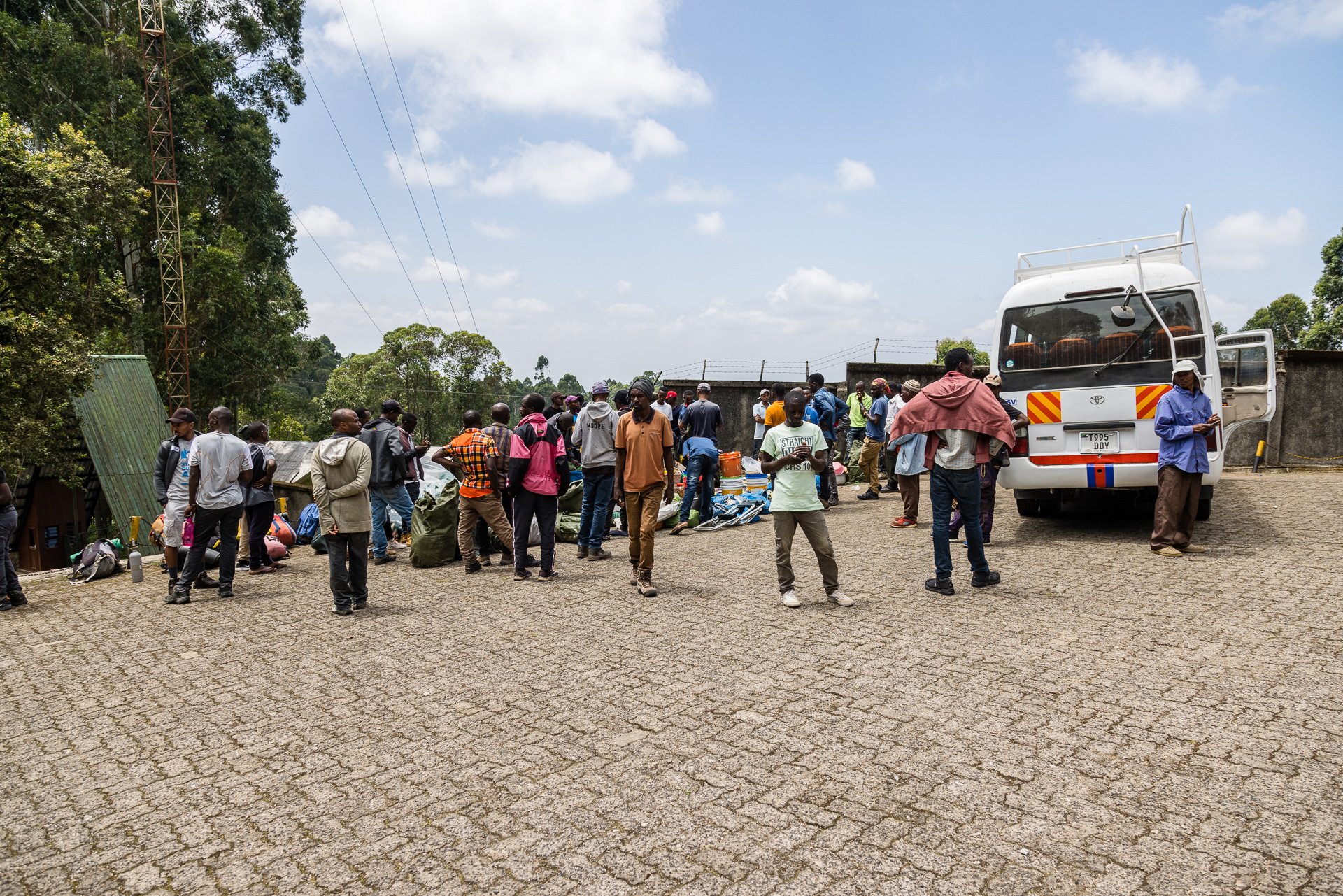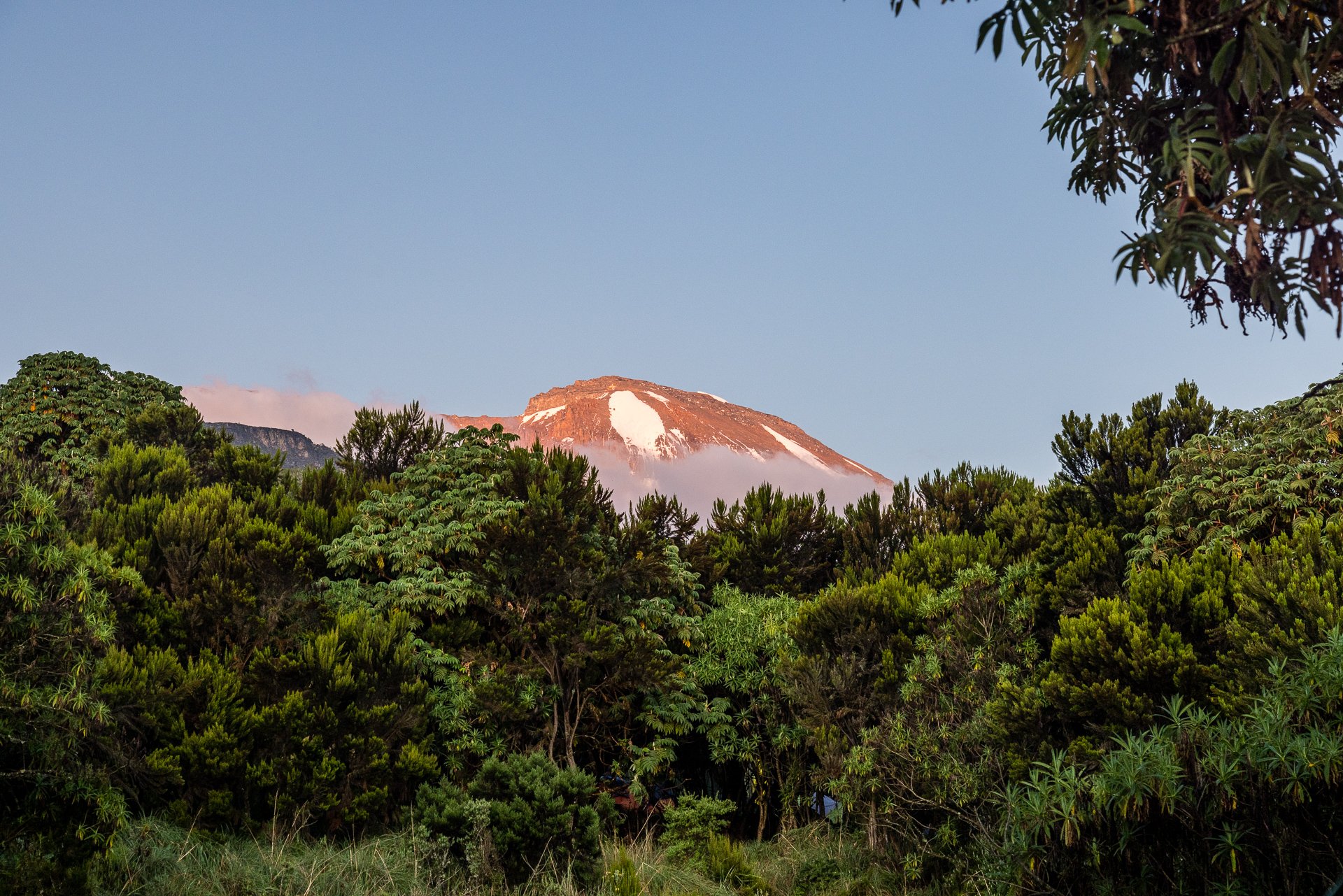01 - Machame Gate - Machame Camp
Trail Information
Distance: 11km
Difficulty: Easy
Transport: Private bus to Machame Gate
Terrain: Kilimanjaro spans five ecological zones. Each day progresses through one or more of them.
-
Where people live, work and farm. this is the main altitude of Tanzania.
-
Mountain forests and evergreen. Heavy rainfall and high humidity.
-
The start of lower oxygen and stranger flora. There is little tree cover and the change from rainforest to moorland is both dramatic and obvious.
-
You will see some real changes in your body at this altitude, very few animals and plants live at this level.
-
Hail, snow, freezing winds are all possible. Nothing lives at this altitude. Rocks and stones are your only friends.
Technically you pass through both the culitvation zone and rainforest zone during the course of this day, but Machame Gate is at the very upper end of the Cultivataion Zone and the first steps out on the trail are a thick forest, the rest of the acent from your hotel is done by bus so doesn’t really count.
Accommodation & Shopping
Machame Gate
Altitude: 1,640 meters
The Gate is one of a handful of entrances to Kilimanjaro and the start of the Machame Route. Many tours will prepare a lunch or breakfast for hikers on their trips, served in covered terraces with seating and long tables. A tiny shop selling soft drinks, cigarettes, chocolate and a few other items including souvenirs is also in the covered area, offering some final luxuries before the climb, but little that will help if you realise you’ve forgotten something.
Further up, the porters strip down the buses and repack everything into their heavy bags. Each porter carrying about twenty kilos and the most junior lumbered with the portable toilet.
By the gate, locals with various souvenirs keep watch like hawks waiting for any attention so they can try to sell you something.
The Experience
Day 1
A fairly early start, at 6:45 AM and a brief sighting of a cool bird outside that flew away before I could get his photo marked the start of my Kilimanjaro trek. My room-mate and I got showered (for the final time for a week) and headed down for breakfast and to meet the rest of our hiking crew. I filled up on eggs, refried beans, French toast and some really good fruity local coffee. Our group was a mix, three women and seven men. from mid-twenties to sixty and from all over the world.
We dropped our gear at reception and checked in whatever we didn’t need to a storage room to pick up once we’d conquered Kili. I was ruthless with myself and had two lenses backed for my hike. A 24-105mm that I’d be carrying on my camera and a 20mm f2.8 in my evening bag carried by the porter for low light or evenings and that would come to the summit with me as it was lighter than the 24-105. All my other lenses for the Serengeti were left with the hotel.
Moshi Mall
Our first stop was actually in the opposite direction to the mountain. We headed into Moshi and stopped at a Supermarket and ATM. I made a rookie mistake of having no idea of the exchange rate of Shillings to SEK or Sterling and so tried to take out 200 Shillings. Turns out after a chat with some of the others I should be trying numbers like 200,000 shillings.
I grabbed a coke from the supermarket and immediately remarked on how strangely it tasted. This lead half the group to know I was taking Diamox for altitude sickness as one of the stranger side effects is an unusual effect on the taste of carbonated drinks. After the Supermarket, we briefly stopped at a pharmacy for one of the group to pick up some malaria tablets (I maintained my indifference to them, being rarely bitten and happy to drink quinine infused tonics (even if i’ve given up on the Gin.)
It was a short hours drive from Moshi to Machame Gate, and the start of the hike. We gathered in a covered seating area, had our water bottles and camel bags filled with water and ate a good meal of cucumber soup and macaroni bolognese. A good mix of carbs & protein for the upcoming effort.
Then we started.
Walking up from the covered walkway to the parking lot and round a corner onto the trail. Past a gate where our tickets were checked. The Tanzanian authorities keep a rigorous track over everyone who climbs, completes or abandons the climb to know both the number of people who have climbed the mountain and to make sure no one is lost or missing.
The trail for today was 11 kilometres and an estimated 5 hours duration. We’d be going up over a thousand metres, which would be our normal ascension most days, but starting at 1,800, we’d not be feeling any altitude effects.
The trail is well maintained, with clever cuts across teh trail to direct the rain water away from the trails, as guttering. Wood edging keeps the footing relatively firm, though if wet it can be slippery so advice is to keep your feet on the dirt, not the wood. This is the only day where the trail is this ‘engineered’ as this is also a ‘day trail’ people do to see some of the mountain as part of a tour.
Porters saunter past all the time, we quickly had to get used to them passing, and we learned that as we got higher and higher we’d have to make more effort to keep clear as the pathways become less wide. It is humbling watching the porters easily move past us, with huge bags on their backs or heads, as we have our small daypacks.
Every five or so kilometres, or about ever two hours a hut with a squat toilet can be found. This is also the only portion of the trail where this is the case, they are generally only at the campsites after this day. The toilets are in various degrees of repair and for us they were reasonably clean, but tourism was still only about a quarter of what it would usually be this time of year.
The trail is reasonably easy, perhaps the easiest you’ll do on the hike. You ascend 1,210 meters in 11km, there are a decent number of flat sections and very few really steep ones, mostly setup like a natural staircase. Its mostly just a steady ongoing upwards hike.
Lush, verdant and green, the forest rises up on both sides of the trail, with very few breaks, so your view is quickly monotonous. When there is a break though, it can be spectacular and very different to what you will see as you get higher. At one point a waterfall splashed out of the rocks and down to an invisible river.
Waterfall
The camp-ground, Moshi Camp, came up on us quickly. We went from forest trail to busy campsite in moments. This camp is also the last camp offering a sit down toilet, though you need a certain devil may care attitude to use it as its not the cleanest place to put your bare bottom. The tents had already been setup and we area all given warm water in plastic bowls for ‘washy-washy’ something we’d be getting used to as it was our only way of getting a little bit cleaner. We rinsed of as best we could and then put on some warmer clothes as the sun got lower. Drank some hot drinks and ate some popcorn. We dragged chairs outside from the tent and spent some time looking out at the summit of Kilimanjaro, lit by the last rays of the sun. It seemed impossibly distant for the handful of days it was supposed to take us to reach the peak.
Dinner was filling, fish, vegetables in a sauce and potatoes, with more hot chocolate for me to finish up.
Outside, an incredible blanket of stars had me regretting leaving my tripod at home. With almost no lights other than the occasional torch you would see pinpricks of light everywhere.
We all retired to our bedrolls early, by 9pm, as we were exhausted and we had a 6:20 wake up call to look forward to. I stayed up a little later, taking a few handheld photos of stars and writing a few more paragraphs.
Total Distance: 11km
Altitude Gained: 1,210 meters























